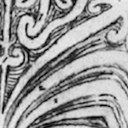0192 Toitu te moko: Maintaining the Integrity of the Moko in the 19th Century and the Work of Gottfried Lindauer
Identifiers (Article)
Identifiers (Files)
Abstract
This essay examines the ways in which the practice of moko changed over the 19th century as critical indicators of the endurance of Māori culture, from its use as signature on documents and land deeds in 1815 to being depicted by European portrait painters such as Gottfried Lindauer. Ultimately, as argued here, the integrity of the moko was maintained as evidenced by the increasing popularity of moko on Māori today.
Moko is an integral part of Māori history and culture. Our art histories track how the practice comes from oral stories relating to Mataora and Niwareka on the one hand, and archaeological and oral evidence brought over from the Pacific on the skins and in the minds of our ancestors. Over the centuries moko became carved into the skin, in doing so differing from the Pacific practice of tatau which is punctured and smooth.
Moko was one of the most intriguing practices that caught the eyes and pencils of early European explorers, most notably from England (Cook) and France (de Surville). With the official arrival of Christianity in 1814, the practice of moko began to change – in some areas where there was close contact it was set aside, but in other it continued throughout the nineteenth century.
By the time Lindauer arrived in New Zealand in 1874 it was mostly women who were receiving the moko, as Māori culture reeled from the processes of colonization (such as the establishment of the Native Land Court) and the New Zealand Wars. The result was tribal peoples often alienated from their ancestral lands and seeking new strategies to survive economically, politically and culturally.
It was these people who Lindauer depicted in his work, whose moko was some of the last done with the old uhi (chisel) technique. There is a variety of moko providing evidence of a wide range of designs across the country. Today these designs are a link through to the past, as descendants and other tribal members look once again to placing these moko on their own skins, to honour their ancestors, and thereby celebrating their survival.
Statistics


License

This work is licensed under a Creative Commons Attribution-NonCommercial-NoDerivatives 4.0 International License.



